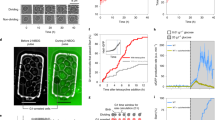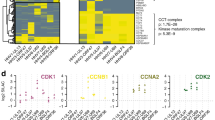Abstract
THE relative importance of Ca2+ and Mg2+ in the regulation of cellular multiplication and alteration of that regulation by viral transformation has recently become a subject of considerable interest1–5. Extracellular Ca2+ and Mg2+ both have effects on metabolic parameters and macromolecular synthesis in cultured cells. Mg2+, because of its substrate level intracellular concentration and its role in macromolecular synthesis and intracellular transphosphorylation reactions, has been suggested as a possible coordinate regulator of the positive pleiotropic response, a coordinated array of reactions associated with initiation of DNA synthesis and multiplication in cultured cells6–9. Ca2+ on the other hand, has been suggested as a short term regulator of cell growth and function, largely on the basis of its tightly regulated low cytoplasmic concentration10,11. In this report, we describe a kinetic analysis of the effects of extracellular concentrations of Ca2+ and Mg2+ on survival and multiplication of normal and transformed human cells in culture. We have found that cellular multiplication rate (number of population doublings per unit time) and also cellular ‘survival rate’ (percentage survival divided by time) can be substituted in place of reaction rate in classical enzyme kinetic formulae (Fig. 1). Both responses exhibit saturation kinetics, with a transition from first order response to zero order, as the concentration of calcium, magnesium, or any other essential component of the culture medium is increased. Rate plotted against concentration yields the expected right rectangular hyperbola described by the Henri–Michaelis–Menten formulation, and the expected linear relation when plotted by the Lineweaver–Burke or van Hofstee methods. Linear regression of the Lineweaver–Burke double reciprocal plot yields from its intercepts a maximal rate for multiplication or survival (equivalent to Vmax in classical enzyme kinetics) and a Michaelis–Menten constant (Km), equal to the substrate (or ligand) concentration yielding a half maximal rate of multiplication or survival.
This is a preview of subscription content, access via your institution
Access options
Subscribe to this journal
Receive 51 print issues and online access
$199.00 per year
only $3.90 per issue
Buy this article
- Purchase on Springer Link
- Instant access to full article PDF
Prices may be subject to local taxes which are calculated during checkout
Similar content being viewed by others
References
Rubin, H. & Koide, T. Proc. natn. Acad. Sci. U.S.A. 73, 168–172 (1976).
Boynton, A. L., Whitfield, J. F., Isaacs, R. J. & Tremblay, R. J. cell. Physiol. 92, 241–248 (1977).
Boynton, A. L. & Whitfield, J. F. Proc. natn. Acad. Sci. U.S.A. 73, 1651–1654 (1976).
Durham, A. C. H. Nature 267, 375–376 (1977).
Rubin, H. Nature 271, 186–187 (1977).
Achs, M., Garfinkel, D. in Regulation and Control in Physiological Systems, (eds Iberall, A. and Guyton, A.) 19–21, (Intl Fed of Automatic Control Symposium, Instrument Soc. of Am., Pittsburgh, Pa., 1973).
Lostroh, A. J. & Krahl, M. E. in Advances in Enzyme Regulation. (Ed. Weber, G.) 12, 73–81 (Pergamon, New York, 1974).
Rubin, H. Proc. natn. Acad. Sci U.S.A. 72, 3551–3555 (1975).
Rubin, H. & Chu, B. J. cell. Physiol. 94, 13–19 (1978).
Rebhun, L. I. Int. Rev. Cytol. 49, 1–54 (1977).
Rasmussen, H., Goodman, D. B. P. & Tenenhouse, A. CRC Crit. Rev. Biochem. 1, 95–148 (1972).
McKeehan, W. L., Mckeehan, K. A., Hammond, S. L. & Ham, R. G. In Vitro 13, 399–416 (1977).
Ham, R. G. & Mckeehan, K. A. In Vitro 14, 11–22 (1978).
McKeehan, W. L., Genereux, D. P. & Ham, R. G. Biochem. Biophys. Res. Commun. 80, 1013–1021 (1978).
McKeehan, W. L., Hamilton, W. G. & Ham, R. G. Proc. natn. Acad. Sci. U.S.A. 73, 2023–2027 (1976).
McKeehan, W. L. & Ham, R. G. J. Cell. Biol. 71, 727–734 (1976).
Ellem, K. O. & Gierthy, J. F. J. cell. Physiol. 92, 381–400 (1977).
Cham, B. E. & Knowles, B. R. J. Lipid. Res. 17, 176–181 (1976).
McKeehan, W. L. & Ham, R. G. In Vitro (abstr) 14, 353 (1978).
Author information
Authors and Affiliations
Rights and permissions
About this article
Cite this article
MCKEEHAN, W., HAM, R. Calcium and magnesium ions and the regulation of multiplication in normal and transformed cells. Nature 275, 756–758 (1978). https://doi.org/10.1038/275756a0
Received:
Accepted:
Issue Date:
DOI: https://doi.org/10.1038/275756a0
This article is cited by
-
A critical review on microbial degradation of petroleum-based plastics: quantitatively effects of chemical addition in cultivation media on biodegradation efficiency
Biodegradation (2022)
-
Quantitative imaging of magnesium distribution at single-cell resolution in brain tumors and infiltrating tumor cells with secondary ion mass spectrometry (SIMS)
Journal of Neuro-Oncology (2016)
-
A tribute to Richard G. Ham (1932–2011)
In Vitro Cellular & Developmental Biology - Animal (2012)
-
TRPM7 is essential for Mg2+ homeostasis in mammals
Nature Communications (2010)
-
Human oral epithelial cell culture I. Improved conditions for reproducible culture in serum-free medium
In Vitro Cellular & Developmental Biology (1990)
Comments
By submitting a comment you agree to abide by our Terms and Community Guidelines. If you find something abusive or that does not comply with our terms or guidelines please flag it as inappropriate.



